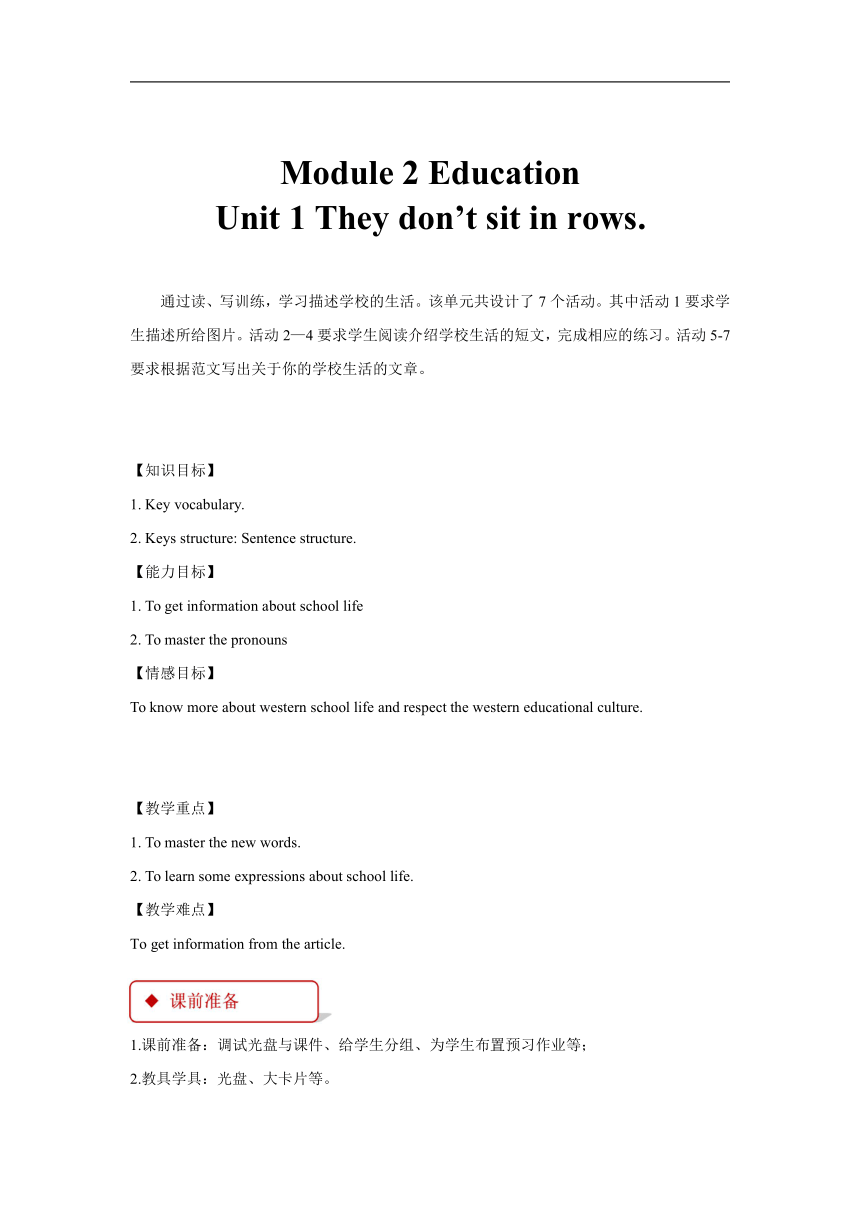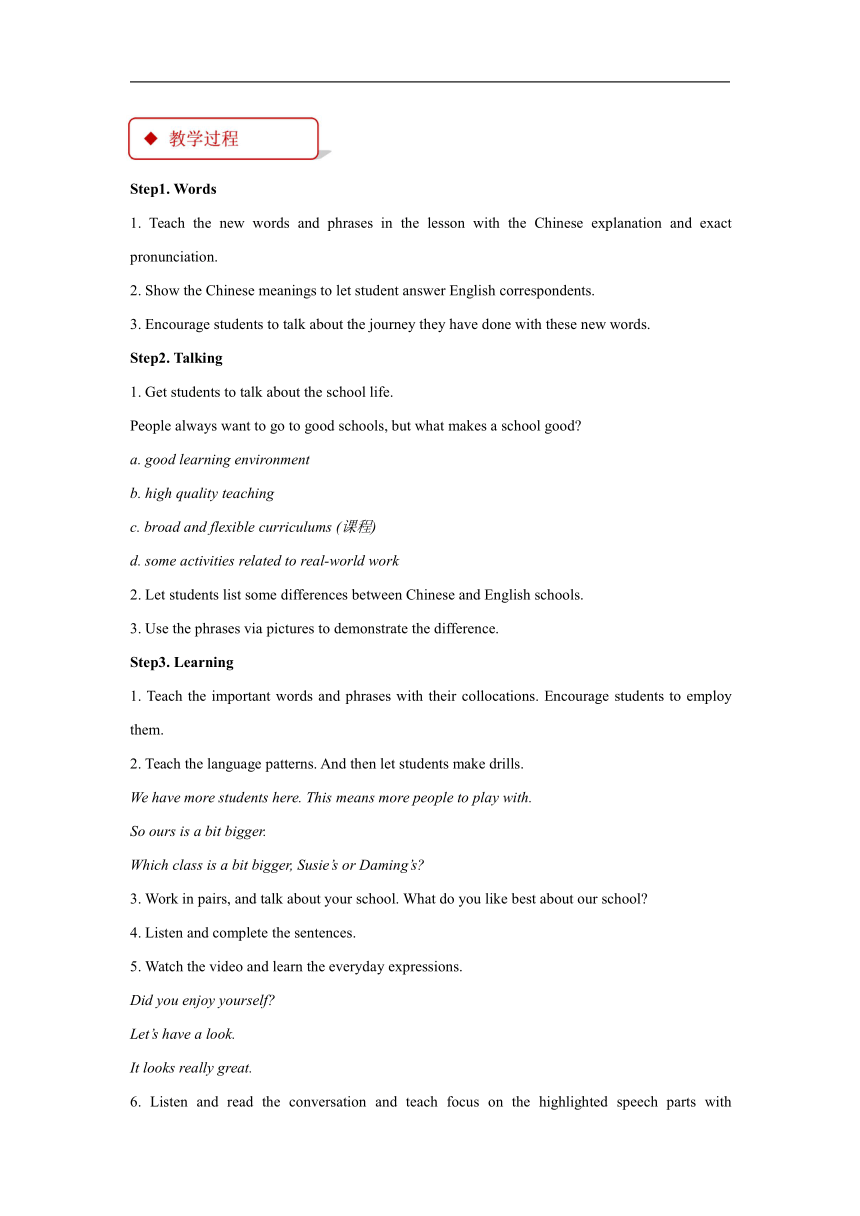Module 2 Education Unit 1 They don’t sit in rows.【教学设计】
文档属性
| 名称 | Module 2 Education Unit 1 They don’t sit in rows.【教学设计】 |  | |
| 格式 | zip | ||
| 文件大小 | 29.3KB | ||
| 资源类型 | 教案 | ||
| 版本资源 | 外研版 | ||
| 科目 | 英语 | ||
| 更新时间 | 2019-02-07 09:15:04 | ||
图片预览


文档简介
Module 2 Education
Unit 1 They don’t sit in rows.
通过读、写训练,学习描述学校的生活。该单元共设计了7个活动。其中活动1要求学生描述所给图片。活动2—4要求学生阅读介绍学校生活的短文,完成相应的练习。活动5-7要求根据范文写出关于你的学校生活的文章。
【知识目标】
1. Key vocabulary.
2. Keys structure: Sentence structure.
【能力目标】
1. To get information about school life
2. To master the pronouns
【情感目标】
To know more about western school life and respect the western educational culture.
【教学重点】
1. To master the new words.
2. To learn some expressions about school life.
【教学难点】
To get information from the article.
1.课前准备:调试光盘与课件、给学生分组、为学生布置预习作业等;
2.教具学具:光盘、大卡片等。
Step1. Words
1. Teach the new words and phrases in the lesson with the Chinese explanation and exact pronunciation.
2. Show the Chinese meanings to let student answer English correspondents.
3. Encourage students to talk about the journey they have done with these new words.
Step2. Talking
1. Get students to talk about the school life.
People always want to go to good schools, but what makes a school good?
a. good learning environment
b. high quality teaching
c. broad and flexible curriculums (课程)
d. some activities related to real-world work
2. Let students list some differences between Chinese and English schools.
3. Use the phrases via pictures to demonstrate the difference.
Step3. Learning
1. Teach the important words and phrases with their collocations. Encourage students to employ them.
2. Teach the language patterns. And then let students make drills.
We have more students here. This means more people to play with.
So ours is a bit bigger.
Which class is a bit bigger, Susie’s or Daming’s?
3. Work in pairs, and talk about your school. What do you like best about our school?
4. Listen and complete the sentences.
5. Watch the video and learn the everyday expressions.
Did you enjoy yourself?
Let’s have a look.
It looks really great.
6. Listen and read the conversation and teach focus on the highlighted speech parts with explanations.
7. Now complete Susie’s column in the table.
8. Answer the questions in the slide according to the conversation content.
9. Complete the passage with the correct form of the words in the box. Teach can show how to use them after students have completed.
enjoy pool row tie wear
10. Work in groups. Choose one plot and act it out to see which group does the best.
Step4. Language points
1. enjoy oneself 玩的开心、玩得高兴
= have fun/ have a good time
enjoy (doing) sth.喜欢(做)某事
2. have a look “看一看”,不能接表示“看什么”的宾语;若表示“看什么” 用have a look at或look at。
3. What is …like? (询问情况)……怎么样?
主要用法如下:
要求对方对特定事物进行描述。
询问天气情况。
用于人时,既可指人的外表,也可指人的 性格、品质。
4. a bit 和 a little都作“稍微;一点儿”
二者的主要用法如下:
a bit 和 a little 在肯定句中修饰动词、形容词、
副词及其比较级,可以换用,表示“一点儿”。
② a bit 和 a little 在否定句中,意思正好相反。
not a bit = not at all 一点儿都不
not a little = very (much) 很、非常
③ a little可以直接作定语修饰名词,而a bit则要在后面加of 构成短语才能作定语,两者都只能修饰不可数名词。
5. wear, put on , dress, be in都有“穿戴”的意思
① wear表示状态,意思是:穿着(衣物) ;戴着(眼镜、帽子、手表等饰品);留着(胡须、头发等);呈现,流露出(…表情)
put on 穿上;戴上 强调“穿”“戴”的动作,后接衣服、鞋帽等。其反义词: take off (脱去) ,指脱去衣物鞋帽。
be in穿着,表示状态,in表示衣服或衣服颜色的词,着重于服装的款式或颜色。
dress 既可表示动作也可表示状态。
dressed是过去分词作定语,作“穿着”(wearing) 解,表示状态, 常用结构be dressed in;
dressing是不及物动词dress的现在分词形式,表示“穿 (衣服)”(putting on a dress)的意思,表动作;
dress sb. 给…穿衣,dress是及物动词。
6. sit in a row 坐成一排
sit around 围坐在……
stand in a row 站成一排
7. one day意为“某一天”、“有一天”,既可用于过去时中,也可用于将来时中。
some?day(或someday)也有“某一天”之意,但它指的是“将来的某一天”,要用将来时。
8.look是感官系动词,其后加形容词作表语。
Step5. Summary
1. Summarize the main sentence patterns in the unit.
2. Show the important phrases to consolidate the learned knowledge.
3. Test students on the spelling and Chinese meanings of words. When finished, students exchange their papers to see who does the best.
Step6. Practice
1.从方框内选择适当的单词填空。
really in a row the other swimming pool
2.选择正确的一项完成句子。
3.翻译句子。
4.单项选择
Step7. Homework
1. Retell the story to your partner.
2. Review the use of new words in Unit 1.
无
同课章节目录
- Module 1 Travel
- Unit 1 We toured the city by bus and by taxi
- Unit 2 It's a long story.
- Unit 3 Language in use
- Module 2 Education
- Unit 1 They don't sit in rows.
- Unit 2 What do I like best about school?
- Unit 3 Language in use
- Module 3 Life now and then
- Unit 1 They sometimes work harder.
- Unit 2 I think life is better today.
- Unit 3 Language in use.
- Module 4 Rules and suggestions
- Unit 1 You must be careful of falling stones.
- Unit 2 we must keep the camp clean.
- Unit 3 Language in use.
- Revison A
- Module 5 Look after yourself
- Unit 1 We'd better get you to hospital.
- Unit 2 Get off the sofa!
- Unit 3 Language in use.
- Module 6 Eating togethe
- Unit 1 When is the school-leavers' party?
- Unit 2 Knives and forks are used for most Western
- Unit 3 Language in use
- Module 7 English for you and me
- Unit 1 Have you ever been to an English corner?
- Unit 2 We all own English.
- Unit 3 Language in use
- Module 8 My future life
- Unit 1 Here's to our friendship and the future
- Unit 2 I know that you will be better at maths.
- Unit 3 Language in use
- Revison B
